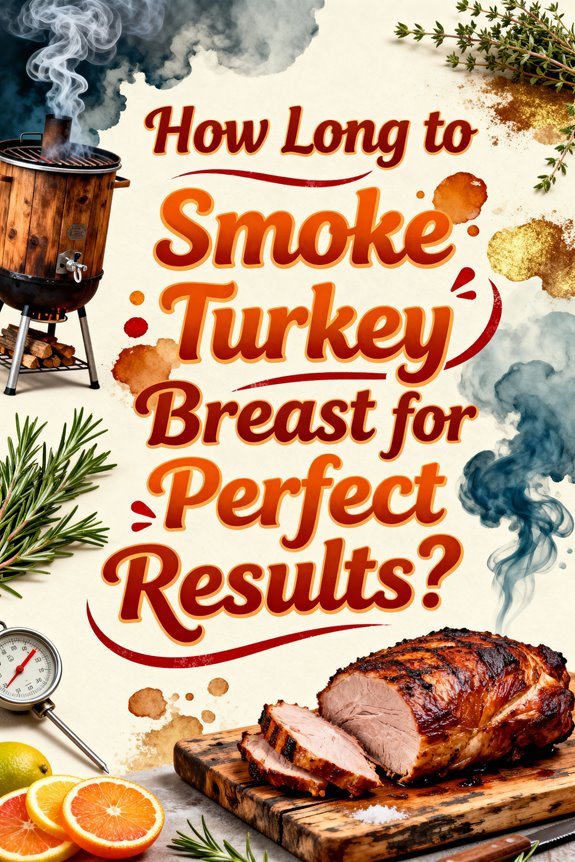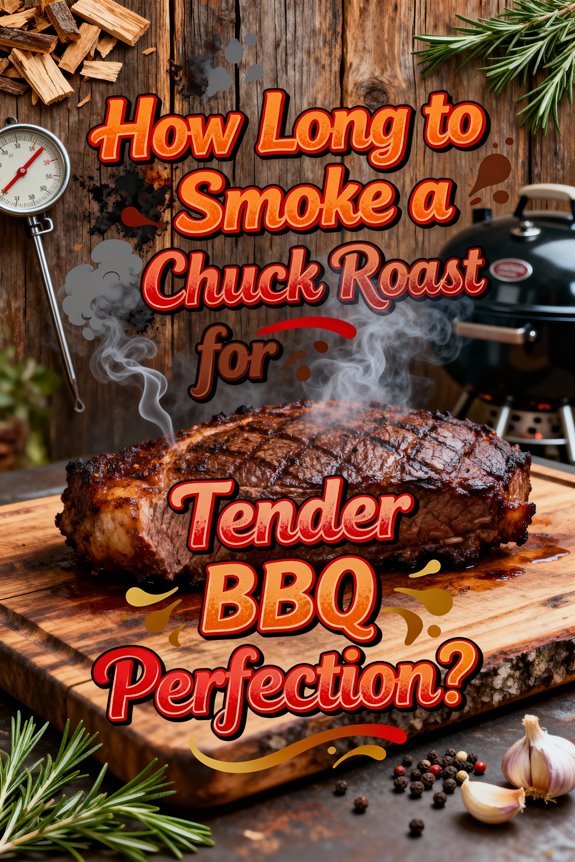You’ll need 60 to 90 minutes to smoke chicken drumsticks at 225°F until they reach the safe minimum of 165°F internal temperature. However, don’t pull them just yet—continue smoking to 175–180°F for ideal tenderness and texture, as dark meat benefits from the higher finish temperature. Use an instant-read thermometer in the thickest part, avoiding bone contact for accuracy. Factor in an additional 15–30 minutes for preheating your smoker, and remember that drumstick size and batch quantity affect total cooking time. Below, you’ll find essential techniques for crispy skin, proper spacing, and wood selection strategies.
Understanding Smoker Temperature for Perfect Drumsticks
Why does smoker temperature matter more for chicken drumsticks than most other cuts? Drumsticks have skin, connective tissue, and dark meat that respond dramatically to heat levels. At 225°F, you’ll achieve deep smoke penetration, but expect rubbery skin—a common pitfall across all smoker types. Higher temps (275°F–285°F) deliver crisper results while still infusing smoke flavor. Similar to medium-high heat grilling, maintaining proper temperature control is essential for optimal results. Just like chicken thighs, drumsticks develop their best smoky depth when cooked low and slow.
Temperature control becomes critical for texture optimization. While 165°F internal temp guarantees safety, drumsticks demand 180°F–185°F to break down collagen properly. Many pitmasters use a two-phase approach: start at 225°F for smoke absorption, then raise to 375°F+ to finish. This method balances flavor with the textural contrast of tender meat and crispy skin. The process offers a consistent cooking time within a 15-minute window, making it easier to plan your meal. Always verify doneness with a meat thermometer regardless of your smoker’s capabilities.
Time Requirements: What to Expect at 225°F
Understanding your smoker’s target temperature sets the foundation, but knowing exactly how long the process takes determines when dinner hits the table. At 225°F, you’ll need 60 to 90 minutes for chicken drumsticks to reach the safe internal temperature of 165°F. Your smoker setup requires 15 to 30 minutes of preheating before you start cooking.
The variation in smoking duration depends on drumstick size and quantity. Larger pieces naturally demand more time, while proper marination can slightly reduce cooking duration through better moisture distribution. Under ideal conditions—stable temperature, proper air circulation, and favorable weather—you’ll achieve consistent results. Some pitmasters prefer a two-step cooking method that involves finishing at higher temperatures to achieve extra crispiness. Many experts recommend applying apple cider vinegar during smoking to keep the meat moist. Check internal temperature regularly using a reliable thermometer. Don’t rely on timing alone; temperature accuracy guarantees both safety and quality in your finished product. For maximum tenderness, consider cooking drumsticks to at least 180°F rather than stopping at the minimum safe temperature.
Target Internal Temperatures for Safety and Tenderness
Use a reliable instant-read thermometer in the thickest part, avoiding bone contact. If you’re glazing, apply sauce at 165°F, then return drumsticks to the smoker until they hit 175–180°F. This approach satisfies both safety requirements and delivers the tender, succulent dark meat you’re after. For fall-off-the-bone results, you can push drumsticks up to 190°F while maintaining optimal texture. Don’t settle for merely safe—aim for exceptional. Consider starting with air-dried legs for the crispiest possible skin texture. Woods like pecan or hickory complement drumsticks perfectly without overwhelming their natural flavors.
Preparing Your Drumsticks Before Smoking
Achieving those perfect internal temperatures starts well before your drumsticks hit the smoker—proper preparation sets the foundation for both safety and superior texture.
Begin by selecting uniformly sized, fresh drumsticks and patting them completely dry with paper towels—moisture is the enemy of bark formation and smoke adhesion. Similar to ham, maintain a steady cooking temperature between 225°F and 250°F for optimal results. For enhanced flavor penetration, consider brining techniques: submerge drumsticks in a saltwater solution for 4–12 hours, then rinse and dry thoroughly before proceeding.
Apply a light coating of oil, then generously cover with your preferred dry rubs, ensuring complete coverage. Like chicken thighs, drumsticks need to reach 165°F internal temperature for safe consumption. For maximum flavor development, refrigerate seasoned drumsticks overnight. Before smoking, allow them to rest at room temperature for 20–30 minutes and arrange with adequate spacing on your rack for ideal smoke circulation. Keep the skin on to retain the juiciness of the meat during the smoking process.
Wood Selection and Flavor Profiles
The wood you choose fundamentally shapes your drumsticks’ flavor profile, transforming straightforward poultry into a nuanced culinary experience. Understanding wood characteristics determines whether you’ll achieve delicate sweetness or bold intensity. Apple and cherry deliver gentle, fruity notes that complement rather than overpower—ideal for brined drumsticks. Hickory provides robust, assertive smoke favored in Southern traditions, while pecan offers nutty warmth without bitterness. Oak presents balanced, versatile smoke suitable for beginners, and maple adds subtle sweetness that blends well with other varieties. Effective flavor pairing considers preparation methods: fruit woods excel with marinades, while stronger woods suit dry rubs. Mix woods strategically—maple with pecan creates complexity, oak provides consistency. Control smoke exposure carefully; excessive duration produces acrid flavors regardless of species selection. Use completely dry wood to produce clean smoke and avoid adding chicken until blue smoke appears. Similar to how zucchini planks ensure even cooking on the grill, proper wood selection ensures uniform smoke penetration throughout your drumsticks. Maintaining proper airflow control through vent adjustment helps regulate smoke intensity and temperature stability.
Monitoring Doneness: Thermometer Techniques
Accurate temperature measurement separates perfectly cooked drumsticks from undercooked hazards or dried-out disappointments. You’ll need an instant-read thermometer with fast response time—critical for quick, precise readings. Insert the probe into the thickest part of each drumstick, avoiding bone and fat which skew results considerably. Bone contact gives falsely high readings, while fat pockets read too low. Your target is 165°F minimum for food safety, though some prefer 170°F for peak texture. Using an indirect heat setup helps maintain consistent temperature readings throughout the cooking process.
For best flavor development, choose hardwood fruitwoods like cherry or maple when smoking your drumsticks. Thermometer placement requires deliberate technique. Angle the probe through the meat’s center, feeling for resistance that indicates proper depth. For optimal texture in dark meat, consider cooking drumsticks to 185°F to 190°F which maintains exceptional moisture and tenderness. Regular thermometer calibration guarantees accuracy—test yours in ice water (32°F) or boiling water (212°F) monthly. Keep a backup thermometer available; equipment failures happen when you least expect them.
Achieving Crispy Skin After Smoking
Perfect temperature means nothing if you’re left with rubbery, unappetizing skin—the most common complaint among backyard pitmasters. Chicken skin preparation starts before smoking: pat drumsticks completely dry, then refrigerate exposed for an hour to eliminate surface moisture. Apply a light cornstarch-seasoning mixture to absorb any remaining dampness.
During smoking, temperatures below 225°F won’t render fat properly. Once drumsticks hit 165°F internally, increase your smoker to 300–325°F for the final phase. This higher heat renders subcutaneous fat and crisps the exterior without overcooking meat. For even better results, drizzle olive oil onto each drumstick and rub it over the skin before applying your cornstarch and seasoning blend. Like testing a steak’s doneness, using a meat thermometer provides the most accurate results for perfectly cooked chicken. Modern pellet grills offer precise temperature control that helps maintain consistent heat throughout the cooking process.
For maximum results, finish with direct heat—a quick torch pass or two-minute broiler blast transforms texture dramatically. These crispy skin techniques guarantee your drumsticks deliver both smoke flavor and satisfying crunch.
Spacing and Arrangement on the Smoker Grate
Proper airflow determines whether your drumsticks smoke evenly or emerge with pale, undercooked patches alongside charred spots. Position each drumstick at least one inch apart on the grate—this spacing technique allows smoke and heat to circulate completely around each piece. Arrange them in a single layer perpendicular to the grate bars to prevent rolling and guarantee stability throughout the cook. For optimal tenderness, aim for low and slow cooking at temperatures between 225-250°F. Just as with uniform sizes in kabob preparation, consistent spacing ensures even cooking across all pieces.
Avoid stacking or clustering drumsticks together, as this creates steam pockets that’ll give you rubbery skin instead of the bark you’re after. Your drumstick arrangement should maximize surface exposure while preventing contact points. If you’re working with limited grate space, use an additional rack positioned above the first layer rather than cramming pieces together. Woods like hickory or applewood will infuse bold or sweet flavors depending on your preference. Insert your thermometer into the thickest section without touching bone for accurate readings.
Resting and Serving Your Smoked Drumsticks
Once your drumsticks hit the target internal temperature of 175°F to 185°F, pull them from the smoker and let them rest for 5 to 10 minutes—this pause redistributes the juices that heat has driven toward the center, preventing them from flooding your cutting board the moment you bite in. Tent them loosely with aluminum foil to retain heat without steaming the skin. Remember that carryover cooking will raise the internal temperature by 3-5°F during this window, so you can pull them slightly early if needed. Just as with turkey smoking, using an instant-read thermometer ensures safe and properly cooked meat throughout. For ideal resting techniques, balance foil coverage with brief air exposure to preserve crispness. When ready to serve, these serving tips guarantee quality: plate them warm within 10 to 15 minutes, use pre-warmed plates, and pair with sauces applied post-rest for maximum flavor impact. Tenting with aluminum foil for about 10 minutes after smoking allows the chicken to rest properly while maintaining temperature. For extra crispy skin, consider a final high heat finish by raising the smoker temperature to 375-400°F for 10-15 minutes before resting.
Storage and Reheating Tips for Leftovers
After enjoying your smoked drumsticks, you’ll want to preserve their quality through proper storage techniques. Refrigerate leftovers within two hours in airtight containers, where they’ll stay safe for 3–4 days. For extended storage, wrap drumsticks tightly in heavy-duty foil and freeze for up to three months. Proper thawing methods include using your refrigerator, cold water bath, or microwave to safely defrost frozen chicken.
When reheating, always reach an internal temperature of 165°F to address safety concerns. Use your oven at 325–350°F for 10–15 minutes, placing drumsticks on a rack over water-filled pans to maintain moisture. Avoid using a microwave for reheating, as this can compromise the texture and moisture of the smoked chicken. Air fryers and grills work excellently for crisping skin. Adding a splash of broth while reheating helps maintain the meat’s natural juiciness.
Transform leftovers into leftover dishes by shredding meat for salads, sandwiches, soups, or pasta. Discard any chicken showing spoilage signs—sliminess, off odors, or discoloration—and never leave cooked chicken at room temperature beyond two hours.







